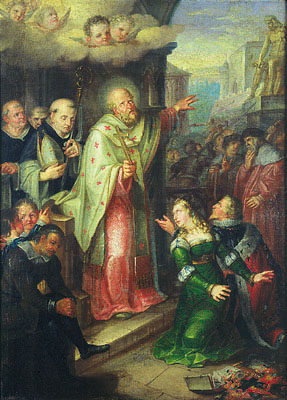
A nation within a nation and a pact that would lead to one of the deadliest wars the world would ever see, thousand years later.
Story in the evening ...
Story in the evening ...
https://twitter.com/Arby_K/status/1354980107467640835
Ludmilla was born around 860 to Slavibor ze Pšova. Around 874, she married Bořiwoj, Duke of Bohemia. Bohemia was a subordinate duchy of Moravia, ruled then by Svatopluk. His death in 894 led to the eventual collapse of the Moravia. 1/10 

Bořiwoj and Ludmilla were baptized by the Byzantine Bishop Methodius. Bohemia and Moravia were stuck in between a grand power struggle between the Holy Roman Empire, the Byzantines and the Bulgars, which Svatopluk used to his advantage. 2/10 

The East Frankish King Arnulf had earlier allied with the Magyar tribes to pacify Moravia. After Svatopluk's death, he tried again and was more successful. In 895, Ludmilla's son, Spytihněv, who had become Duke after his father's death, swore fealty to Arnulf. 3/10 

As East Francia evolved to become Germany, Bohemia would continue to remain as a crucial part of that nation. The Magyar invite by Arnulf would lead to the invasion of the Carpathian basin by the Magyar, creating a new country for themselves, out of the collapsed Moravia. 4/10 



Spytihněv died in 915 and was followed by brother Vratislav as Duke. Ludmilla was entrusted with the responsibility of raising her grandson, Wenzel, who succeeded his father as Duke in 921. Ludmilla had brought Wenzel up as Christian, but it was opposed by many in his court. 5/10 

Ludmilla's main rival in court was her daughter-in-law, Drahomíra. The rivalry would end with Ludmilla's assassination, but Duke Wenzel would send his mother to exile soon. A "proxy war" reflecting the conflict between Bavaria and Saxony in East Francia also played a role. 6/10 

In 929, the East Frankish King, Heinrich of Saxony, invaded Bohemia jointly with his new ally, Arnulf of Bavaria. Duke Wenzel had to pay a tribute resulting in a coup orchestrated by his brother, Boleslav, in 935. Boleslav would rule Bohemia till his death in 967. 7/10 

Despite his contentious inheritance, Boleslav would prove to be an able ruler, eventually taking the lead in bringing Bohemia closer to East Francia, allying with King Otto at Lechfeld in 955 to finally finish the Magyar threat and adding former Moravian lands to Bohemia. 8/10 

In 1085, Duke Vratislav was crowned King and after 1185, all monarchs of Bohemia were Kings within the Holy Roman Empire. Duke Vladislav became the Cup Bearer of the Empire in 1114, paving way for Bohemia to become Imperial Elector and some of its rulers becoming Emperors. 9/10 

Bohemia ended up in Habsburg hands after the Battle of Mohacs in 1526 and become part of the Austrian Empire in 1804. But the long association with Germans would be a crucial point in the Sudeten crisis of 1938 leading to Germany annexing the region after Munich Agreement. 10/10 

• • •
Missing some Tweet in this thread? You can try to
force a refresh














